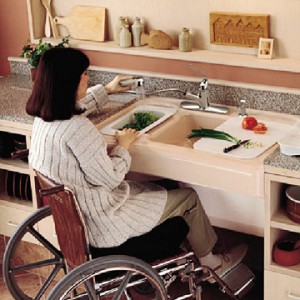Quite often it is the home that presents the greatest difficulties through limited mobility or other physical impairments to seniors as they age in their existing living surroundings. Designing for specific physical conditions will lessen the impact of say arthritis, restricted mobility, or loss of vision by using combinations of products, concepts, and techniques available today. These aging in place changes can actually increase the value of your home as you are able to appeal to multiple generations of home buyers. In some cases, those who are doing only consultations are not the ones actually implementing those suggestions or doing the home modifications, which is left up to contractors. However, a CAPS certified remodeler or contractor providing a one stop shop is even more valuable to anyone wanting to age in place. Their construction knowledge enables any aging in place design to come to fruition via practicality and best practices. Complete aging in place services and the knowledge of how to carry them out are available to the homeowner through CAPS certified remodeling. On the other hand, any knowledgeable advice from a CAPS certified individual is still valuable. It’s up to these consultants to make sure they charge for their assessment and advise for modifying the home. They will be additionally compensated for their design and once again for a detailed drawing. CAPS professionals are generally paid by the hour or receive a flat fee per visit or project. Typically an assessment takes approximately 60-90 minutes. It’s best if you or a family member can accompany the professional during the home safety assessment, as you or they can ask questions about specific safety items as they come up. A comprehensive Home Safety Assessment can pay for itself by avoiding the high cost of injury or assisted living.

CAPS stands for Certified Aging-in-Place Specialist. It is a construction credential that has builders, architects, remodelers, designers and even occupational therapists buzzing. Far beyond using universal design ideas, aging in place or independent living principles are sweeping changes designed to custom fit your home to you and your family as time goes by. CAPS design takes your current and future circumstances into consideration. CAPS design principles focus on elegant, aesthetically enriching, barrier free environments. Home modifications do not need to look institutional and this is why many seniors are resisting the very changes that can help them the most. The vast majority of builders and remodelers do not have the knowledge and training to perform home modifications for aging in place. When considering installing a grab bar which seems like a simple endeavor, a run of the mill contractor or handyman has no idea of the safety regulations involved or the knowledge of where to install the grab bar leaving the consumer in an unsafe situation. These are changes that can actually increase the value of your home once they are performed correctly.
Construction and design professionals are taking advantage of the CAPS training across the nation. This designation is taught through the National Association of Home Builders in collaboration with AARP. CAPS connects responsible professionals with home owners who need these services on an ever increasing basis. CAPS is a nationwide initiative and all active CAPS professionals can be found at nahb.org/CAPSdirectory. David L. Traut, CAPS the owner of T-Square Company in Austin, Texas is one of the select group of professionals nationwide to earn the Certified Aging-In-Place Specialist (CAPS) designation, identifying him as a home remodeler and builder with the skills and knowledge necessary to remodel or modify a home to meet the unique needs of the older population, disabled owners, or their visitors.
There are really three categories of aging in place customers. Those who are simply and wisely planning ahead for their futures to remain in their present homes. The second category concerns those people who know they have a chronic medical disorder and need to prepare in advance for accessibility issues which will come as a result of their disease. People with diseases that are constantly causing increased physical or mental changes to their being are a good representative of this second group. The third group involves those people who either have had a chronic problem that has progressed severely altering their mobility or those who have sustained a life altering tragedy such as being involved in an accident. All of these groups will drive the future metamorphosis of existing inaccessible dwellings. The goal of an accessible bathroom design in Austin is to make the bathroom a safe space for everyone who uses the facilities. Aging in place services use universal design to accommodate wheelchair use and can make the bathroom more comfortable for all generations with or without specific needs. It is important to carefully outline the scope of work during the remodeling of an accessible bathroom by first taking inventory of the users capabilities, needs, and preferences. All disability home remodeling or disability bath remodels in Austin must be done considering all the data provided by the client, his or her family, and any caretakers involved. Aging in place design must be carried out by an aging in place specialist who is also a reputable residential remodeling professional.
During a home assessment for increasing accessibility the structural needs of the client will be noted and documented through sketches, photos, and conversation. All the surroundings will be taken into account from the flooring to the layout of a specific room or location as it pertains to the inhabitant's ease of usability. The physical and emotional needs of the occupant will also come into play because of mobility, sensory, or cognitive concerns. The goal is to modify the home in a custom manner to provide for the maximum health, independence, and safety of the occupant. Often the input from any caretakers like a physical or occupational therapist during the assessment phase can prove to be invaluable. The three main rooms involved in aging in place home modifications are the bathroom, the kitchen, and the family room in that order. These areas make up the most occupied spaces of any home and will be connected by a designated accessible route. The basic needs involve access through wider doorways, non slip floor surfaces, and adequate cabinet and plumbing fixture accessibility. What is more important is that we must observe safety for everyone as the baby boomers choose to age in place within their homes. For more information about T-Square Company, visit www.tsquareco.com or call 512-444-0097.













